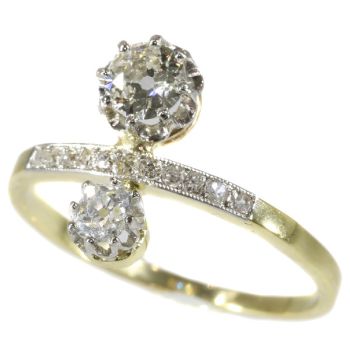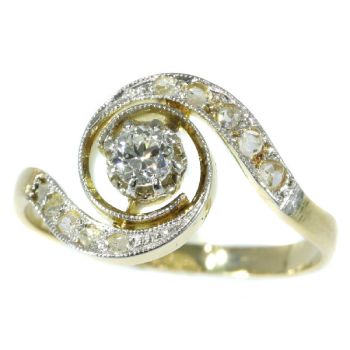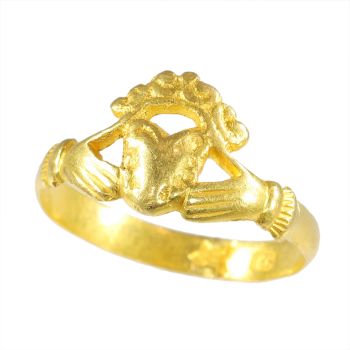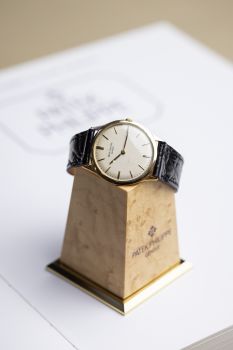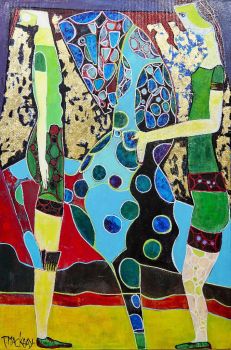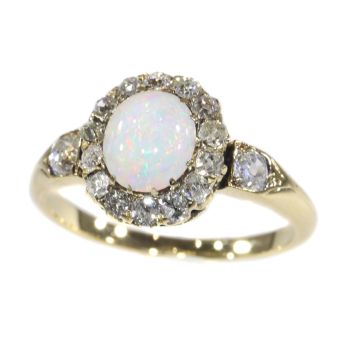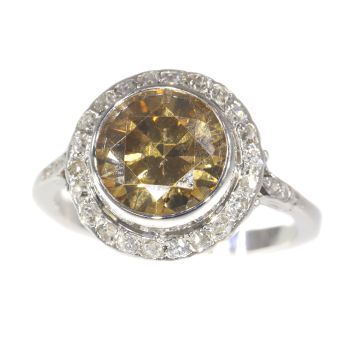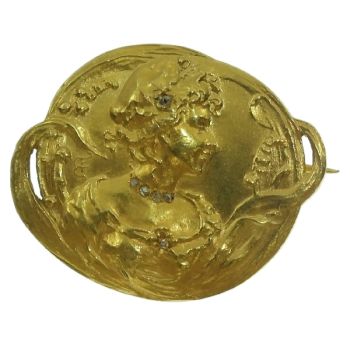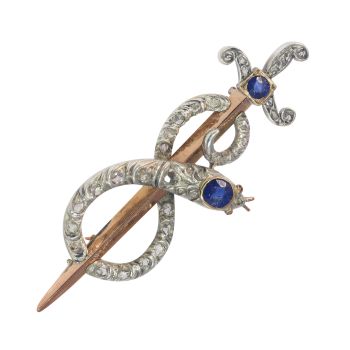Antique 18K Gold Baroque Wedding Band, Circa 1700 – A Timeless Symbol of Love 1700
Unknown artist
Gold
€ 8.200
Adin Fine Antique Jewellery
- About the artwork
Imagine wearing an antique wedding band from circa 1700, a rare piece crafted in 18K yellow gold, with alternating lozenge shapes and stylised floral motifs set upon delicate filigree wirework. This beautiful ring, with its Baroque charm, is not just apiece of jewellery; it’s a tangible connection to history, symbolising the enduring nature of love. To wear such a ring as a symbol of your marriage is to carry a piece of timeless elegance, a link to centuries past, as you begin your own journeytogether.
Antique jewelry object group
ring, wedding band
Condition
very good condition
more info on our condition scale
Country of origin
Netherlands
Style
Baroque - Baroque is an artistic style that dominated Europe from the late 16th century to the early 18th century. Often described as "the leading style in European art between the Mannerist and Rococo periods, characterised by dynamic movement,heightened emotion, and bold expression."
Find more info on Baroque
more info on styles
Style specifics
Baroque is a style in art and decoration that developed shortly before 1600 and remained current in Europe until the emergence of the Rococo style c.1730. It was started in Italy, and spread to Germany, Austria, the Low Countries, and Spain andPortugal, with only a somewhat severely classical version being popular in France under Louis XIV. The style was a development of the Renaissance style and is characterized by lively, curved, and exuberant forms, by vigorous movement, and by richornament, based on classical sources, being symmetrical as distinguished from the asymmetry of the following Rococo style.
Period
ca. 1700
Events & facts of this era, poetry of this era, fashion of this era.
Material 18K
warm yellow gold (touchstone tested)
more info on precious metals
Technique
This jewel features a filigree decoration, which is in fact thin gold wire twisted into refined motifs, in this case elegant little balls. You can also notice the use of granulation on this piece. Granulation is a technique where the goldsmith uses very small balls (granules) of metal, which are not soldered to the piece but welded. Both techniques demand very high skills and precision from the maker.
Hallmarks
On the outside of the ring is a hallmark from the Kingdom of the Netherlands, a flowered letter V, used for foreign and small domestic works between 1814 and 1831. On the inside, there are older hallmarks that require further research, but one appears to resemble a 'U' shape, with a standing lozenge between the open arms of the 'U', possibly encircled by a halo-like feature (possibly a year letter?). The distinct character of these marks suggests that the ring could date back to around 1700.
more info on hallmarks
Dimensions
band width 0,75 cm (0,30 inch)
see picture with a ruler in millimeters and inches
Weight
4,30 gram (2,76 dwt)
Ring size Continental EU: 62 & 19¾ , Size USA: 10 , Size UK: T½
Resizing
Resizing is possible but because of the age of the ring we prefer to leave it untouched. Return policy on this ring is not valid anymore once this work has been done.
more info on ring sizes
Adin Reference Nº
24121-0313
Copyright photography
Adin, fine antique jewellery
Additional information
our latest acquisitions
jewelry glossary
wall of fame
visit us in Antwerp
subscribe to our mailinglist
- About the artist
It might happen that an artist or maker is unknown.
Some works are not to be determined by whom it is made or it is made by (a group of) craftsmen. Examples are statues from the Ancient Time, furniture, mirroirs, or signatures that are not clear or readible but as well some works are not signed at all.
As well you can find the following description:
•“Attributed to ….” In their opinion probably a work by the artist, at least in part
•“Studio of ….” or “Workshop of” In their opinion a work executed in the studio or workshop of the artist, possibly under his supervision
•“Circle of ….” In their opinion a work of the period of the artist showing his influence, closely associated with the artist but not necessarily his pupil
•“Style of ….” or “Follower of ….” In their opinion a work executed in the artist’s style but not necessarily by a pupil; may be contemporary or nearly contemporary
•“Manner of ….” In their opinion a work in the style of the artist but of a later date
•“After ….” In their opinion a copy (of any date) of a work of the artist
•“Signed…”, “Dated….” or “Inscribed” In their opinion the work has been signed/dated/inscribed by the artist. The addition of a question mark indicates an element of doubt
•"With signature ….”, “With date ….”, “With inscription….” or “Bears signature/date/inscription” in their opinion the signature/ date/ inscription has been added by someone other than the artist
Are you interested in buying this artwork?
Artwork details
Related artworks
Artista Sconosciuto
A Japanese bronze Hu flower vase, Edo / Meiji, 19th century19th century
Prezzo su richiestaMenken Works of Art
1 - 4 / 12Artista Sconosciuto
A pair of angels Antwerp, 17th century, Carrara marble17th century
Prezzo su richiestaFrederik Muller
Artista Sconosciuto
A Surinam-themed Amsterdam long-case clock1746 - 1756
Prezzo su richiestaZebregs & Röell - Fine Art - Antiques
 A cura di
A cura diGallerease Magazine
Artista Sconosciuto
Verre à boire Cristallo façon de Venise1600 - 1650
Prezzo su richiestaPeter Korf de Gidts - Antiquairs
Artista Sconosciuto
Een Gotische zuidelijke Nederlanden wandklok1580 - 1590
Prezzo su richiestaNico van den Assem restauratie
Eduard Charlemont
‘Allegories of Africa and America’1872
Prezzo su richiestaZebregs & Röell - Fine Art - Antiques
Peter Paul Rubens (circle of)
Portrait of a man dressed up as an oriental man1620 - 1630
Prezzo su richiestaGallerease Selected
1 - 4 / 24- 1 - 4 / 24
Artista Sconosciuto
Art Deco speld met Saffier1920
Prezzo su richiestaAnita Potters Juwelier Antiquair
Artista Sconosciuto
A superb Indonesian royal gem-set gold overlaid silver betel box19th century
Prezzo su richiestaZebregs & Röell - Fine Art - Antiques
1 - 4 / 24- 1 - 4 / 12

















































